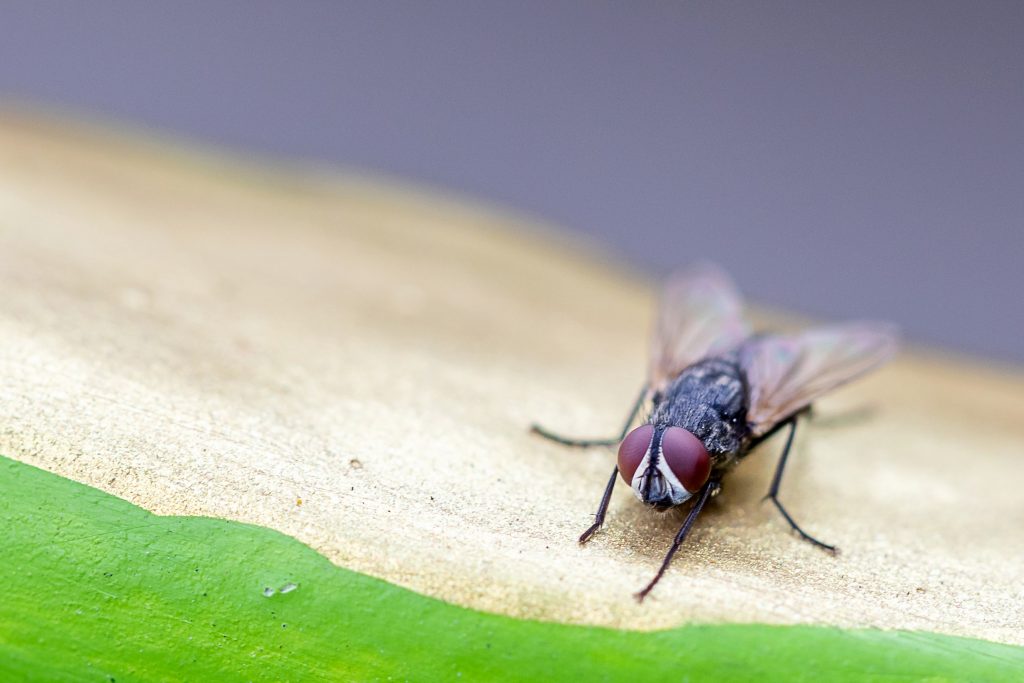You may have seen cluster flies (also sometimes known as scuttle flies, blow flies and bottle flies) buzzing around your kitchen or near the front door of your home, but you might not be sure what they are, how to get rid of them, or if they’re dangerous. To help you get rid of cluster flies and prevent them from coming back, here’s everything you need to know about these pests—and the best way to eradicate them from your home once and for all.

What Causes Cluster Flies?
Two species of cluster flies, known as lesser and greater house flies, are native to North America. Cluster flies belong to a larger family of house fly (Muscidae) that also includes blue bottles and filth flies. Depending on where you live, you may only see cluster flies during summer months or throughout the year if your home is near a breeding ground for these insects. When a female cluster fly senses food, she leaves her eggs—called egg pods—on surfaces in dark corners around your home. As more time passes without getting rid of cluster flies, they multiply and infest areas in your home with eggs. The most common cause of an ongoing cluster fly problem is poor sanitation, so it’s important to eliminate cluster flies from your home by cleaning up after meals. Removing any pet waste from around your property can also help reduce an infestation since dogs and cats often attract flies looking for a place to lay their eggs. Dead animals, such as a squirrel, raccoon or rat in an attic or basement is another potential source. Properly disposing of garbage is another way to get rid of cluster flies; don’t leave containers outside overnight or store trash in an unsecured area around your home. You should take away whatever attracted them in the first place! This step is particularly important before spring planting season when flies look for plants to lay their eggs next to come springtime. A popular way to eliminate cluster flies early on is by using pesticides, but there are many natural options that work just as well.
What Do Cluster Flies Look Like?
Cluster flies are small, black flies with a yellow underbelly. You may see cluster flies resting on walls or ceilings around your home, but you’ll likely only see them in action—hovering in a cluster—during warm-weather months. When disturbed by a person or animal, cluster flies disperse quickly and remain hidden until nightfall. Cluster flies have a typical fly lifespan of 2–3 weeks; however, they can multiply rapidly if they go unnoticed during daylight hours. If left unchecked for too long, their presence can escalate quickly and become overwhelming; if one is spotted inside your home, it’s time to call an exterminator immediately.
The adult cluster fly about a half-inch in size, which is slightly larger than a common housefly. These flies often show up in houses, shops, and restaurants where they are drawn by light. They’re often found near windows because it takes so little for them to be able to get inside your home—even cracks as small as 1/32 of an inch will allow them access.
Why Do I Have Cluster Flies in My Home?
There are many reasons why you might have cluster flies in your home, but they all boil down to one thing: food. Cluster flies don’t really like you or your furniture—they just want a meal and somewhere warm and dry to lay their eggs. Like most pests, getting rid of cluster flies involves a little detective work to discover where they’re coming from and what it is that attracts them in the first place. The good news is, once you find out what that source is, eliminating cluster flies can be as simple as removing it from your environment.
Are Cluster Flies Dangerous?
Nasty cluster flies can be annoying but they’re typically not dangerous. If you suspect you have a severe infestation, call an exterminator immediately as heavy cluster fly populations could spread disease. Do-it-yourselfers might attempt to handle small clusters on their own (as long as children and pets are kept away) by putting out traps and spraying for food sources or laying down bait. Keep in mind that cluster flies aren’t just found in homes; they can be found at farms, stables, zoos and other outdoor locations that provide ample shelter for them. It might take more than one go-round before your population is finally under control.
How Do I Get Rid of Cluster Flies?
If you have cluster flies in your home, you need to get rid of them fast! And for good. While many fly species are relatively harmless, cluster flies are definitely not. They often appear as a product of moisture or sewage buildup, so if you have one (or several) infestations in your home or business it’s likely that there is some sort of moisture issue going on. What kinds of issues can cause an infestation? Basements and crawlspaces with water issues, leaky pipes and HVAC systems are common culprits—but depending on where you live, even normal rainfall and humidity can be enough to create these pests. In any case, here’s how to eliminate cluster flies from your life forever: Call out the pros – Really, your best bet for long-term peace of mind is by hiring a professional pest management company to take care of your problem. Depending on how long you’ve had clusters around and how big they are, they may be able to come out quickly and dispose of them humanely or help you set up better defenses against their return.
If you have a cluster fly infestation and need help getting rid of them, contact My Pest Pros today at 703-665-4455. and schedule your treatment! Our trained professionals can help identify the source and protect your family against these and other pests.